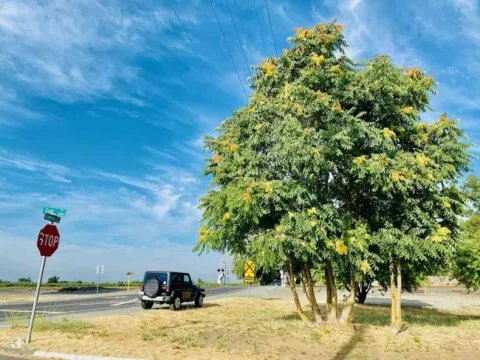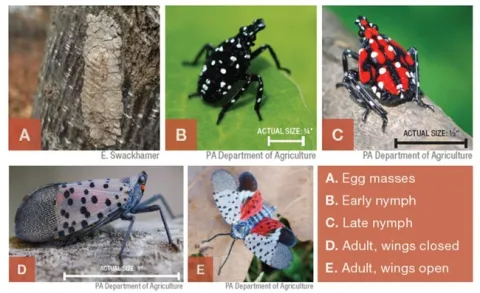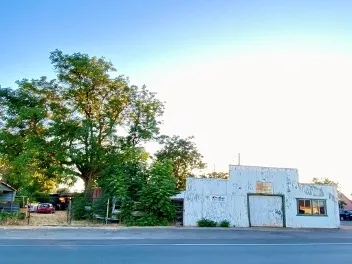Who would have thought that the tree in Betty Smith's famous novel, A Tree Grows in Brooklyn, was the infamous Tree of Heaven (Ailanthus altissima)? Today, unfortunately, the Tree of Heaven has become the harbinger of ecological disaster, because it is the preferred host to the notoriously invasive and deadly planthopper, the spotted lanternfly (SLF). Hence its occasional nickname the Tree of Hades.
The tree has a long history in its native countries, central China and Taiwan, but it was introduced to Europe by a Jesuit priest named Nicolas d'Incarville, who sent seeds to Paris from Beijing in 1743. Fast forward to the 1850s in California during the Gold Rush, when the Chinese planted these trees to remind them of home. They have since spread like wildfire. Look around your neighborhood, and you will probably spot these ubiquitous trees growing in disturbed soil, or along the freeways, in meadows, along agricultural field edges or in empty lots. In fact, it's the widespread population of the Tree of Heaven across the United States that has made the SLF able to hitchhike from the East Coast where it was first discovered in Berks County, Pennsylvania, in 2014, to the West Coast, where it is feared this deadly insect will establish itself in California.

A large female Tree of Heaven with clumps of samaras (winged seeds) on public property next to railroad tracks and vineyards in Acampo, California. Photo taken in June 2024 by Stephanie Bolton, Lodi Winegrape Commission.
Crouching at the Door
Although SLF has not established itself in California to date, 11 egg masses on a 30-foot metal sculpture originating in New York City were spotted at a California Department of Food and Agriculture Truckee Agricultural Inspection Station in March 2024. The truck was sent back to Nevada, where 30 more egg masses were found. The truck received a power wash and was allowed through to Sonoma, where another inspection found 3 additional masses. Read the original press release from the California Association of Winegrape Growers about this first California infestation here.
Since the adult will lay its egg masses on anything stationary—rocks, metal, patio furniture, even railroad cars parked at a station—it becomes very easy for them to hitchhike to new territory, then find their favorite host plant, the Tree of Heaven, or other favored plant, nearby. These insects will take several years to establish themselves, but then become virtually impossible to eradicate, as many communities on the East Coast are experiencing.

The spotted lanternfly from egg mass to adult
Spotted Lanternfly Weakens Plants
Once established, spotted lanternflies are swarm feeders with up to 400 insects per vine or branch, weakening the plant. They feed on the sap of the tree or vine, including wine grapes, hops, maples, black walnuts, and fruit trees. Besides feeding on sap, they also leave behind a sticky honeydew residue on the clusters and leaves. Their activities stress the plants, decrease vine health, and in some cases, can lead to plant death. It's easy to understand why local tree fruit and winegrape growers are preparing themselves to be ready to respond when, not if, SLF sightings are made in San Joaquin County. Besides the potential disaster to the health of the tree or vine, if a crop is produced for export, many countries will not accept produce from areas where SLF is established.

A Tree of Heaven growing in a vineyard near Stockton. Photo by Stephanie Bolton, Lodi Winegrape Commission.
Lodi Grape Growers Respond
Growers are not standing idly by, waiting for disaster to strike Lodi's winegrowing region. They have sprung into action, as Dr. Stephanie Bolton of the Lodi Winegrape Commission reported in the Lodi Wine Grower's Summer 2024 newsletter:
“Over the past year, California outreach efforts have mainly focused on the spotted lanternfly quarantine, creating a statewide action plan and educating people on how to identify and report the spotted lanternfly. We believe it is time for the next step and we are actively taking that step in Lodi. Thanks to our East Coast colleagues who are already battling the negative effects of the spotted lanternfly, we know that there is more we can do right now to protect our vineyards and California agriculture from the spotted lanternfly: We can immediately remove the insect's preferred host plant, the Tree of Heaven, from our vineyard areas and our transportation pathways. The Tree of Heaven is an invasive noxious weed that is undesirable and extremely harmful to both ecosystems and infrastructures. It emits chemicals that are toxic to other plants and has been known to cause thousands of dollars' worth of damage to underground pipes - one person shared online that this tree grew through her house and started coming out a light fixture in a bathroom.
“At the Lodi Winegrape Commission, we're encouraging targeted removal of the Tree of Heaven on vineyard properties and transportation pathways this summer and we need everyone to get involved and help with this grassroots effort. Removal of a Tree of Heaven colony usually takes several years so we need to get started now. Solano County already has a funded vineyard-specific Tree of Heaven removal program through their County Agricultural Commissioner's Office.
We're educating our broader winegrowing community, which for us includes growers, wineries, pest control advisors, consultants, conservation groups, city/county/state officials and citizens, on why we need to urgently remove the Tree of Heaven and how to properly remove it after inspecting it for the spotted lanternfly. About 75 people gathered at the Lodi Winegrape Commission's monthly Integrated Pest Management meeting on July 2 to learn more and left armed with the knowledge they need to join in the effort. We won't be able to stop the spotted lanternfly from entering California, but at least there is something in our power that we can do right now to help protect our vineyards.”

A huge Tree of Heaven with many offspring in Victor, CA. Ed King, Solano County Agricultural Commissioner, shared that “the more we've looked for Tree of Heaven, the more we've found.” Photo by Stephanie Bolton, who, July 1, 2024.
How You Can Help Identify Tree of Heaven and Spotted Lanternfly
The first step in defeating the spotted lanternfly is to locate the Tree of Heaven. UC Master Gardeners are educating themselves to recognize it and acting as scouts, keeping an eye out for trees in their communities. Members of the public can help too. Both this YouTube video and e-learning course from the University of California are available to any interested member of the public who chooses to take an active role in identifying the Tree of Heaven and spotted lanternfly or just wishes to become better educated. Your local Agricultural Commissioner or the California Department of Food and Agriculture should be notified of any sightings, as described here. Please join us in this important fight.

